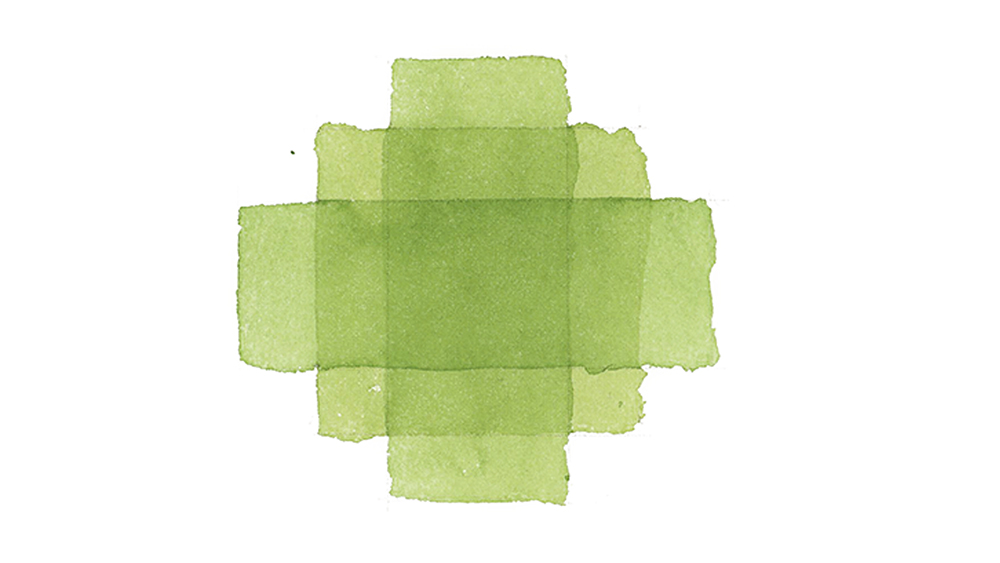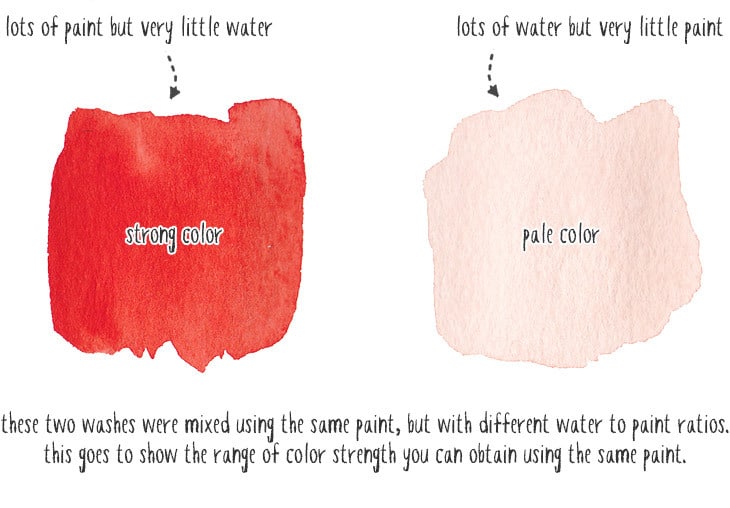
Discover the Truth About Watercolors
In the previous lesson we talked about how watercolors are transparent in nature. I believe this transparency is what contributes to the extraordinary beauty of this medium!
But the transparency of your brush strokes can vary significantly.
A brush with lots of pigment makes bold, colorful marks, while a brush with diluted paint creates lighter, delicate marks. This is all about adjusting the amount of water you mix with your paint, known as “water-to-paint” ratios.
This may sound tricky, but it’s just about learning when to add more or less water to your paint.
Water to paint ratios
I’m going to teach you all about “water-to-paint ratios” for watercolor. This is how you produce different mixing strengths for this type of paint. Water is used to dilute the paint to make it lighter and more transparent. Controlling this is one of the first steps to successful painting with watercolors.
Watercolors are very accessible and extremely rewarding, so I’m excited that you decided to take the leap and begin painting in this wonderful art medium. I remember how difficult I found watercolors when I first started. I would try hard to get the paint to do what I wanted, and ended up pulling my hair out! I began to wonder why I couldn’t get the results I hoped for. At the time, the internet didn’t exist (yes… I know… old huh?). So it was through trial and error that I learned to improve. Nowadays it’s so much easier to find help.
I put together these essential tips in the hope that they’ll avoid you the same frustrations…
Water + Color
Watercolor is made up of two main components: water + color.
Err… I know that sounds pretty obvious, but when you start learning watercolors one of the mysterious parts is knowing exactly how to handle the paint. And the important thing to master is how much water should you use for a particular color appearance?
Water is what you use to dissolve your paints. Watercolor paints are composed of microscopic colored pigments mixed with some other ingredients.
“Just add water” and the magic begins!
When you add clear water, the colored pigments mix with the water to form a pool of liquid paint.
So how do you know how much water to use? The answer is pretty simple, but getting the hang of it can take a while (don’t worry, I have some tips and tricks for you so this doesn’t become over complicated).
Mixing strength
Once you’ve learned to control the mixing strength of your paint you’ll be better equipped to paint the way you want. The “mixing strength” simply means how much water you add to the raw paint. The basic rule is simple:
- When you add a small amount of water to paint, you get a strong, dark-toned appearance.
- When you mix watercolor paint with lots of water it results in a light-toned, pale color appearance.

It’s quite common to make the mistake of not adding enough water, or inversely, adding too much!
To progress with watercolors it’s useful to practice how to produce the color strength you need while you’re painting.
If your paint is too thin, the results can look pale and flat.
If your paint is too thick, you’ll never be able to paint light tones and highlights.
And in general, for a painting to look convincing you need a range of color intensities from light to dark.
Like anything in life, practice makes perfect!
So…
Water-to-Paint Ratio Practice Exercise
To get an idea of how to control your mixing strength you can try the following simple exercise.
Draw a series of circles onto a sheet of watercolor paper. The aim is to paint a series of shapes with varying color intensity, ranging from very pale to very strong.

- Begin by putting a big puddle of clear water in the middle of your mixing palette.
- Using a damp brush, pick up a tiny amount of pigment from one of your colors and mix it into the puddle of water.
Tips & Tricks
Use a scrap sheet of paper to test the color appearance of your brushstroke before you apply the paint. I do this all the time because it’s a quick and effective way to see the results of your mixing.
Light tones are actually quite tricky to mix. You may THINK you’ve mixed a pale watery color, but when you test the color appearance it looks stronger than expected. If this is the case, pick up some more clear water with the brush and add it to your mixing puddle. Test the strength of the mix each time.
- When you’re happy with the results, paint the first circle in a light transparent color.
More Tips
Watercolor paint always dries lighter in appearance compared to when it is wet. It’s much easier to paint light then progress to dark tones than the other way around!
- Now pick up some more paint using the tip of your brush and add it to the mixing puddle.
- Darken the intensity of the color in small stages until you reach the final circle.
- The last circle should be mostly paint and very little water. If you’re finding it difficult to mix a strong color you can reverse your mixing method – in other words start a new puddle using a wet brush to pick up pigment directly from the color well. Don’t add any more water.
At the end of the exercise you should have a series of colored blobs each one darker and more intense in color. The aim is to practice mixing colors which range from very pale to very intense. Getting a steady distribution of intensity from light to dark can be tricky!
Practicing this on some spare paper is useful for refining your mixing skills. When you mix colors in your palette you’ll find yourself constantly adjusting the intensity of the paint either by adding more pigment to your mixing puddle or adding more water.
Eventually it will become second nature, especially if you observe your painting carefully.
Although I have to admit – I still use a scrap piece of paper for testing !!
Congratulations !
Give yourself a pat on the back. You are now one step closer to greater success with your watercolor painting!
Summary
Ok… Just to recap. The water to paint ratio of watercolors is what produces the difference in color intensity and transparency for this art medium.
Practice your mixing strength a few times and this is something that you’ll soon get the hang of.
P.s. Now that you know how to better control your water to paint ratios, you are now one step closer to being able to produce impressively realistic paintings!
But another big question is mixing the actual color your really want!
In the next lesson you’ll learn my magic formula for mixing paints to help make a huge difference to your watercolor artwork!

Anthony
P.S. (IMPORTANT) If you enjoyed this and want more I strongly suggest you “whitelist” my email address (which is [email protected]). Recently, Gmail and some others have started blocking important emails because of updates to their spam filters. I will not spam you. And you can unsubscribe any time you want. I will, however, send you promotions for my watercolor courses… Please note that any purchase is entirely discretionary. Everything else is free. So if you want to keep receiving my painting tips, please put my email in your “safe senders” list. And to find out how to do this, read this page…